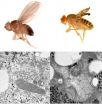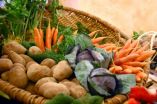(Press-News.org) A study by the team headed by Lluís Ribas de Pouplana, ICREA professor at the Institute for Research in Biomedicine (IRB Barcelona), has been chosen as "Paper of the week" in the December issue of the Journal of Biological Chemistry, which is already available online. The article describes the discovery of a new protein in the fly Drosophila melanogaster (fruit fly) that is crucial for mitochondria. The removal of SLIMP in these flies leads to aberrant mitochondria and loss of metabolic capacity, thus causing death.
The study, whose first author is Tanit Guitart, a PhD student in Ribas' lab, has been recognised as "Paper of the week" award because of the "significance and global relevance" of the research performed. Furthermore, the editors have included it among the best studies that have appeared in the journal this year. Of the 6600 articles published, only between 50 and 100 receive the distinction of "Article of the week".
Result of animal evolution
The SLIMP protein derives from a seryl-tRNA synthetase, universal enzymes that are crucial for the synthesis of new proteins. However, SLIMP has lost its original function and performs a different biological role, which remains to be determined. The researchers studied its possible implication in the regulation of mitochondrial division and the interaction with nucleic acids (DNA, RNA).
SLIMP evolved by duplication of the seryl-tRNA synthetase about 540 million years ago, at the beginning of the Cambrian, before the appearance of the starfish and sea urchins family. SLIMP is not present in vertebrates, and it is possible that another protein has taken over its function. "If this were the case, we could look for the protein equivalent in vertebrates, determine its function and focus on these organisms. Here we have work for the next ten years", says Ribas. This study was performed in collaboration with researchers in the groups devoted to "Heterogenic and Multigenic Diseases" and "Chromatin structure and function", both at IRB Barcelona.
INFORMATION:
Reference article:
A new aminoacyl-tRNA synthetase-like protein in insecta with an essential mitochondrial function
Tanit Guitart, Teresa Leon Bernardo, Jessica Segalés, Thomas Stratmann, Jordi Bernués and Lluís Ribas de Pouplana
Journal of Biological Chemistry (2010) [DOI: 10.1074/jbc.M110.167486]
Scientists at IRB Barcelona discover a new protein critical for mitochondria
This finding has brought them the 'paper of the week' of the Journal of Biological Chemistry, one of the journals of greatest impact in basic biology
2010-11-03
ELSE PRESS RELEASES FROM THIS DATE:
Brain's ability to selectively focus/pay attention diminishes with age
2010-11-03
A University of Toronto study shows that visual attention -- the brain's ability to selectively filter unattended or unwanted information from reaching awareness -- diminishes with age, leaving older adults less capable of filtering out distracting or irrelevant information.
Further, this age-related "leaky" attentional filter fundamentally impacts the way visual information is encoded into memory. Older adults with impaired visual attention have better memory for "irrelevant" information. The research, conducted by members of U of T's Department of Psychology, will ...
Shift work linked to higher risk of work injury: UBC study
2010-11-03
Canadians who work night and rotating shifts are almost twice as likely to be injured on the job than those working regular day shifts, according to a study by researchers at the University of British Columbia.
The study, published in the current issue of the Scandinavian Journal of Work, Environment and Health, examined data on more than 30,000 Canadians collected as part of Statistics Canada's Survey of Labour and Income Dynamics and compared results between workers involved in different types of shift work from 1996-2006. It shows that while the overall rate of work ...
Every person emits 2 tons of CO2 a year through eating
2010-11-03
Every person emits the equivalent of approximately two tonnes of carbon dioxide a year from the time food is produced to when the human body excretes it, representing more than 20% of total yearly emissions. That is what a study by the Universidad de Almería says, confirming for the first time that human excrements contribute to water pollution, primarily with nitrogen and phosphorus.
A team of researchers from the Universidad de Almería (UAL) has estimated the environmental impact of the Spanish diet and role that human excrements play in the life cycle of food. It is ...
Algae for biofuels: Moving from promise to reality, but how fast?
2010-11-03
A new report from the Energy Biosciences Institute (EBI) in Berkeley projects that development of cost-competitive algae biofuel production will require much more long-term research, development and demonstration. In the meantime, several non-fuel applications of algae could serve to advance the nascent industry.
"Even with relatively favorable and forward-looking process assumptions (from cultivation to harvesting to processing), algae oil production with microalgae cultures will be expensive and, at least in the near-to-mid-term, will require additional income streams ...
Exposure of humans to cosmetic UV filters is widespread
2010-11-03
Amsterdam, 2 November, 2010 - An investigation conducted in the context of the Swiss National Research Programme (NRP50), Endocrine Disrupters: Relevance to Humans, Animals and Ecosystems, demonstrates for the first time that internal exposure of humans to cosmetic UV filters is widespread.
In the course of the Summer and Fall 2004, 2005 and 2006 (3 cohorts), human milk was sampled by mothers who had given birth at the University Women's Hospital in Basel. The participants filled out a detailed questionnaire with general questions and, as special feature, in depth questions ...
New long-range undersea robot goes the distance
2010-11-03
Over the past decade, the undersea robots known as autonomous underwater vehicles (AUVs) have become increasingly important in oceanographic research. Today's AUVs fall into two groups: 1) propeller-driven vehicles that can travel fast and carry lots of instruments, but are limited to expeditions of only a few days; and 2) "gliders," which can stay at sea for weeks or even months at a time, but cannot travel very quickly. MBARI engineers recently demonstrated a new super-efficient AUV that combines the best of these two approaches. This new long-range AUV (LRAUV) can travel ...
Mayo Clinic Proceedings: November highlights
2010-11-03
The November issue of Mayo Clinic Proceedings includes three articles with leading research, highlighted below.
Khat Chewing Increases Risk of Stroke and Death in Patients With Acute Coronary Syndrome
ROCHESTER, Minn. -- Researchers found that people who chew khat and present with acute coronary syndrome had significantly higher rates of death, cardiogenic stroke, and stroke complications, despite having lower cardiovascular risk profiles.
"The leaves of khat, a leafy green shrub, are chewed habitually for euphoric and stimulating effects. The main ingredients, ...
First peer-reviewed study finds BPA levels in US foods 1,000 times less than limits
2010-11-03
Note to journalists: Please credit the journal or the American Chemical Society as publisher of this report.
WASHINGTON, Nov. 2, 2010 — For the first time in the United States, researchers are reporting in a peer-reviewed scientific journal today detection of Bisphenol A (BPA) in fresh and canned food as well as food wrapped in plastic packaging. The amounts in the limited sample, however, were almost 1,000 times lower than the "tolerable daily intake" levels set by the U.S. Environmental Protection Agency (EPA) and the European Food Safety Authority (EFSA). Their report ...
Mouse model confirms mutated protein's role in dementia
2010-11-03
A team of scientists from Japan and the University of California, San Diego School of Medicine have created a new mouse model that confirms that mutations of a protein called beta-synuclein promote neurodegeneration. The discovery creates a potential new target for developing treatments of diseases like Parkinson's and Alzheimer's.
The work is published in today's issue of Nature Communications. Lead author is Makoto Hashimoto of the Division of Chemistry and Metabolism, Tokyo Metropolitan Institute for Neuroscience, with colleagues including Eliezer Masliah, MD, professor ...
New research from Psychological Science
2010-11-03
A Spontaneous Self-Reference Effect in Memory: Why Some Birthdays Are Harder to Remember Than Others (http://pss.sagepub.com/content/21/10/1525.abstract)
Selin Kesebir and Shigehiro Oishi
People may have a better memory for birthdays that are closer to their own: Volunteers recalling their friends' birthdays tended to remember birthdays that were closer to their own than birthdays that were farther away from their own birthday. In a separate experiment, after reading brief biographies of people they did not know, volunteers correctly remembered the birthdays of the ...
LAST 30 PRESS RELEASES:
Korea University researchers discover that cholesterol-lowering drug can overcome chemotherapy resistance in triple-negative breast cancer
Ushikuvirus: A newly discovered giant virus may offer clues to the origin of life
Boosting the cell’s own cleanup
Movement matters: Light activity led to better survival in diabetes, heart, kidney disease
Method developed to identify best treatment combinations for glioblastoma based on unique cellular targets
Self-guided behavioral app helps children with epilepsy sleep earlier
Higher consumption of food preservatives is associated with an increased risk of type 2 diabetes
NTU Singapore-led team captures first-ever ‘twitch’ of the eye’s night-vision cells as they detect light, paving the way for earlier detection of blindness-causing diseases
Global aviation emissions could be halved through maximising efficiency gains, new study shows
Fewer layovers, better-connected airports, more firm growth
Exposure to natural light improves metabolic health
As we age, immune cells protect the spinal cord
New expert guidance urges caution before surgery for patients with treatment-resistant constipation
Solar hydrogen can now be produced efficiently without the scarce metal platinum
Sleeping in on weekends may help boost teens’ mental health
Study: Teens use cellphones for an hour a day at school
After more than two years of war, Palestinian children are hungry, denied education and “like the living dead”
The untold story of life with Prader-Willi syndrome - according to the siblings who live it
How the parasite that ‘gave up sex’ found more hosts – and why its victory won’t last
When is it time to jump? The boiling frog problem of AI use in physics education
Twitter data reveals partisan divide in understanding why pollen season's getting worse
AI is quick but risky for updating old software
Revolutionizing biosecurity: new multi-omics framework to transform invasive species management
From ancient herb to modern medicine: new review unveils the multi-targeted healing potential of Borago officinalis
Building a global scientific community: Biological Diversity Journal announces dual recruitment of Editorial Board and Youth Editorial Board members
Microbes that break down antibiotics help protect ecosystems under drug pollution
Smart biochar that remembers pollutants offers a new way to clean water and recycle biomass
Rice genes matter more than domestication in shaping plant microbiomes
Ticking time bomb: Some farmers report as many as 70 tick encounters over a 6-month period
Turning garden and crop waste into plastics
[Press-News.org] Scientists at IRB Barcelona discover a new protein critical for mitochondriaThis finding has brought them the 'paper of the week' of the Journal of Biological Chemistry, one of the journals of greatest impact in basic biology




